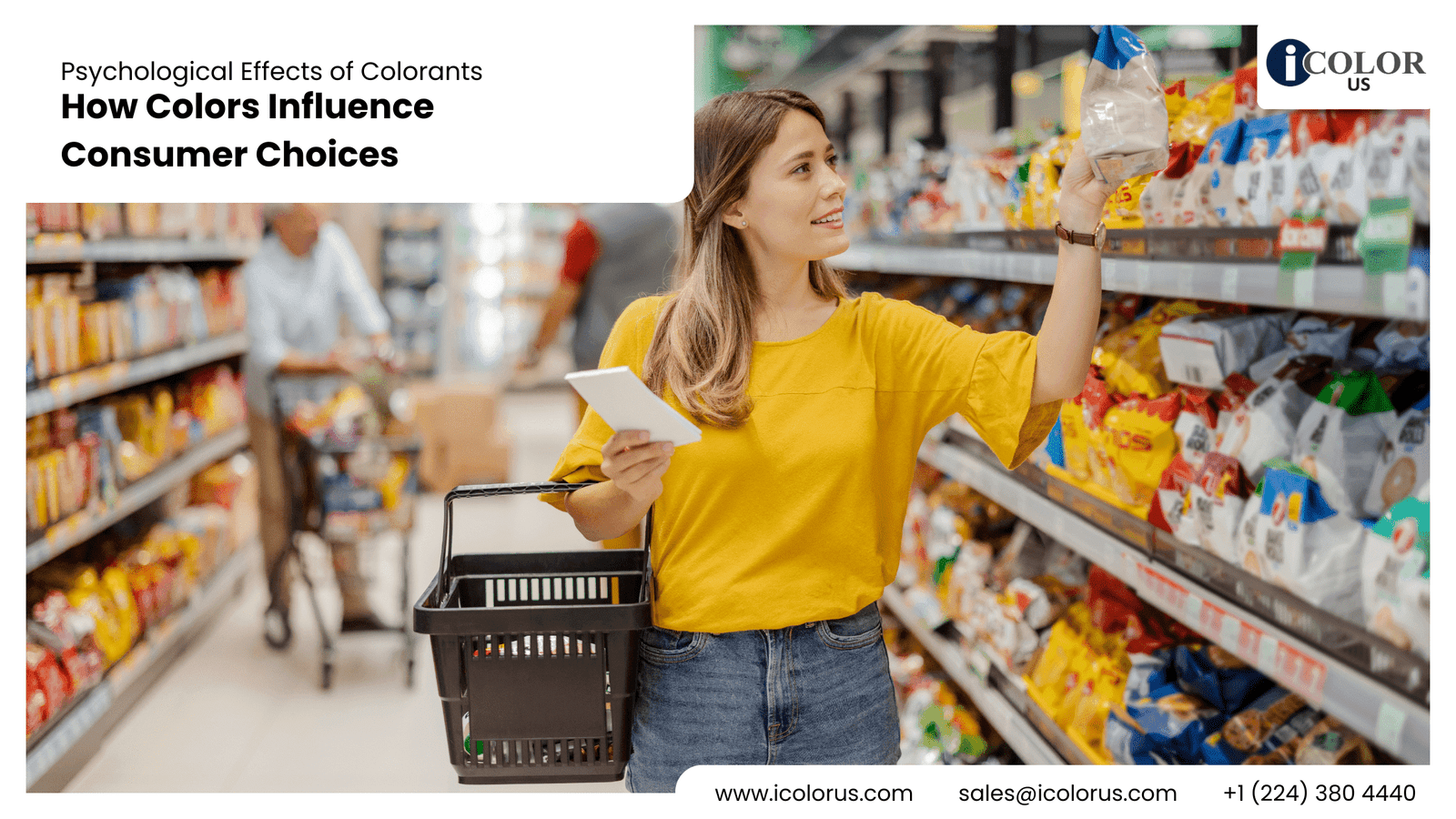Psychological Effects of Colorants – Outline
- Introduction
- Importance of color in marketing and product selection
- Overview of psychological effects of color
- The Science of Color Perception
- How the human eye perceives color
- The role of the brain in color perception
- Color Psychology Basics
- Definition and importance
- Historical context of color psychology
- The Influence of Color on Emotions
- How different colors evoke different emotions
- Examples of emotional responses to colors
- Color and Consumer Behavior
- The impact of color on purchasing decisions
- Studies and statistics on color influence in retail
- Cultural Differences in Color Perception
- How cultural background affects color perception
- Examples of cultural color associations
- Color in Branding and Advertising
- The role of color in brand identity
- Case studies of successful color use in branding
- Color in Packaging Design
- How packaging color affects consumer choices
- Examples of effective packaging color strategies
- The Role of Color in Online Shopping
- Color impact on e-commerce and website design
- Examples of online retailers using color effectively
- Colorants in Food Products
- The effect of colorants on food perception and selection
- Health implications of synthetic vs. natural colorants
- Color in Fashion and Apparel
- How color influences clothing purchases
- Seasonal color trends and their impact
- Psychological Triggers and Color Combinations
- The effect of color combinations on mood and behavior
- Effective color combinations for different products
- Gender Differences in Color Preferences
- How men and women perceive colors differently
- Marketing strategies targeting gender-specific color preferences
- Age Differences in Color Preferences
- Color preferences across different age groups
- Marketing strategies targeting age-specific color preferences
- Conclusion
- Summary of key points
- The importance of understanding color psychology in marketing
- FAQs
- How do colors affect our mood?
- Why is color important in marketing?
- Can color preferences change over time?
- How do cultural differences impact color perception?
- What is the best color for attracting customers?
The Psychological Effects of Colorants on Product Selection
Introduction
Have you ever wondered why you gravitate towards certain products on the shelf? It might be the color that’s catching your eye. Color isn’t just about aesthetics; it plays a crucial role in how we perceive and choose products. From the bright red of a Coca-Cola can to the serene blue of a Tiffany & Co. box, colors are powerful tools in marketing and product selection.
The Science of Color Perception
Our journey into the world of color starts with our eyes and brains. The human eye perceives color through photoreceptors called cones, which are sensitive to different wavelengths of light. When light hits an object, it reflects certain wavelengths that our cones pick up, sending signals to the brain to interpret these as colors.
Color Psychology Basics
Color psychology studies how different hues affect human behavior and emotions. This field has deep roots, going back to ancient civilizations that associated colors with specific qualities and emotions. Today, marketers use these principles to influence consumer behavior.
The Influence of Color on Emotions
Colors can evoke a wide range of emotions. For example:
- Red can stimulate excitement and urgency, often used in clearance sales.
- Blue is calming and trustworthy, which is why many banks and tech companies use it.
- Yellow evokes cheerfulness and is attention-grabbing, perfect for youthful brands.
Color and Consumer Behavior
Studies show that up to 90% of snap judgments about products can be based on color alone. Retailers leverage this by carefully selecting colors that align with their brand and appeal to their target audience. For instance, a study revealed that the color red can increase heart rate and create a sense of urgency, making it effective for promoting sales.
Cultural Differences in Color Perception
Colors don’t have universal meanings; they can vary significantly across cultures. In Western cultures, white is associated with purity and weddings, while in some Eastern cultures, it’s linked with mourning. Understanding these cultural nuances is vital for global marketing strategies.
Color in Branding and Advertising
Brands often have signature colors that become an integral part of their identity. Think of McDonald’s golden arches or Starbucks’ green mermaid. Successful brands use color to create a memorable and consistent image. For example, Coca-Cola’s red is recognized worldwide and evokes feelings of excitement and energy.
Color in Packaging Design
The packaging is the first impression a product makes on a consumer. Colors on packaging can influence perceptions and drive purchasing decisions. For example, eco-friendly products often use green packaging to signify their environmental benefits.
The Role of Color in Online Shopping
In the digital age, the color scheme of a website can significantly affect online shopping behavior. Bright, vibrant colors can attract attention and make calls to action stand out, while a harmonious color palette can enhance the overall shopping experience. Amazon, for example, uses a simple color scheme with orange call-to-action buttons to guide customers through the purchasing process effectively.
Colorants in Food Products
Colorants in food can affect our perception of taste and quality. For instance, we expect certain colors to be associated with specific flavors, like pink for strawberry or green for lime. However, there’s a growing concern about the health implications of synthetic colorants, leading to a preference for natural alternatives.
Color in Fashion and Apparel
Fashion is another industry where color plays a pivotal role. Clothing colors can reflect personal style and even influence mood. Designers and brands pay close attention to seasonal color trends, like the pastel shades of spring or the deep hues of winter, to appeal to fashion-conscious consumers.
Psychological Triggers and Color Combinations
Combining colors can create different psychological triggers. Complementary colors (those opposite each other on the color wheel) can create a vibrant look, while analogous colors (those next to each other) provide a more harmonious feel. Marketers use these combinations to create desired emotional responses in consumers.
Gender Differences in Color Preferences
Research shows that men and women can have different color preferences. Women are generally more sensitive to subtle color differences, while men tend to prefer bold, straightforward colors. Marketers take these preferences into account when designing products and advertising campaigns.
Age Differences in Color Preferences
Color preferences also change with age. Children are often drawn to bright, primary colors, while adults may prefer more subdued shades. Senior citizens might favor colors that are easier to distinguish, such as high-contrast combinations. Brands targeting specific age groups tailor their color choices to align with these preferences.
Conclusion
Understanding the psychological effects of color is essential for effective marketing. Colors can influence emotions, perceptions, and behaviors, making them a powerful tool in product selection. By leveraging color psychology, brands can create stronger connections with their consumers and drive sales.
FAQs
How do colors affect our mood? Colors can evoke a wide range of emotions, from excitement and urgency (red) to calmness and trust (blue). The impact of color on mood can be profound, influencing everything from our shopping habits to our sense of well-being.
Why is color important in marketing? Color is crucial in marketing because it can capture attention, convey brand identity, and influence consumer behavior. The right color choice can make a product stand out and resonate with the target audience.
Can color preferences change over time? Yes, color preferences can change due to various factors such as age, cultural influences, and personal experiences. Marketers need to stay attuned to these shifts to remain relevant.
How do cultural differences impact color perception? Cultural differences can significantly impact color perception. For example, while white symbolizes purity in Western cultures, it can represent mourning in some Eastern cultures. Understanding these differences is essential for global marketing strategies.
What is the best color for attracting customers? The best color for attracting customers depends on the brand, product, and target audience. Generally, red is effective for creating urgency, blue for building trust, and yellow for grabbing attention.





